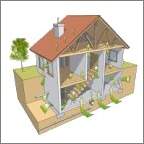Is There Radon in Your Granite Countertop?
by www.SixWise.com
Granite countertops have become the epitome of luxury when it comes to the kitchen. So in-demand is this beautiful and durable material that sales have grown 10-fold in the last decade, reported a recent New York Times article.
|

"Hot" radon-emitting granite countertops are becoming increasingly common, especially among exotic and striated varieties of granite.
|
This same article has brought attention to a serious issue. Because granite is a natural material originating in the earth's crust it can, and often does, contain uranium, which produces radon gas.
"Granite is a naturally occurring igneous rock, meaning that it was formed by the cooling of molten rock. It is quarried and processed to produce commercial products such as countertops. It is possible for any granite sample to contain varying concentrations of uranium that can produce radon gas, a source of alpha and beta particles and gamma rays," according to the U.S. Environmental Protection Agency (EPA).
"Some granite used for countertops may contribute variably to indoor radon levels," the EPA says.
What is Radon and Why is it Risky?
Radon is a natural, radioactive gas that comes from the earth's soil and rocks. Specifically, when uranium in the earth's crust decays, it produces radium, which in turn produces radon.
Radon levels tend to be highest in basements, since they're closest to the soil and rock.
This odorless and colorless gas naturally percolates through porous soils where it enters the air. Outdoors, radon generally is not much of a problem because it rapidly dissipates. Indoors, however, is another story.
Radon gas can enter your home through:
Radon can also be emitted from some home building materials such as the stone used to build fireplaces, solar heating storage systems or the granite in your countertops.
|
Testing Your Home for Radon is Simple: Get Peace of Mind and Protect Your Family
 One out of every 15 homes has elevated radon levels that are the #2 cause of lung cancer in the United States. The EPA and the U.S. Surgeon General recommend that every home get tested below the third floor. Testing is the ONLY way to determine if radon is in your home because it can't be smelled, tasted or seen! One out of every 15 homes has elevated radon levels that are the #2 cause of lung cancer in the United States. The EPA and the U.S. Surgeon General recommend that every home get tested below the third floor. Testing is the ONLY way to determine if radon is in your home because it can't be smelled, tasted or seen!
Testing your home's air for this poisonous gas is easy with the Do-It-Yourself Home Radon Test Kit:
-
Incredibly Simple to Use
-
The U.S.'s top-rated & most trusted home kit
-
VERY economical--Just $9.95 each!
-
Contains everything for a 3-7 day radon test
-
Perform simple test and mail it in ... you'll then be able to access your home's results online!
Read More & Order the EPA-Recommended Home Test Kit Now
|
When radon is inhaled, radioactive particles get trapped in your lungs and break down further, releasing bursts of energy that can lead to cancer. However, the gas causes no immediate symptoms, so damage to lung tissue can occur over a long period of time, sometimes years, without the person knowing.
Radon is, in fact, the second leading cause of lung cancer in the United States (after smoking).
Is Your Granite Countertop "Hot"?
The EPA's recommended safety level for radon is four picocuries per liter of air (pCi/L)) (nearly one out of every 15 U.S. homes has levels at or above this mark!). The New York Times article found at least one home with granite countertops that had levels of 100 pCi/L in the kitchen.
Experts vary on whether or not these "hot" countertops are actually dangerous. Some point out that there's no safe level of radon exposure, while others say the levels are too minute to cause alarm.
"We want to reassure the public that their granite countertops are safe," said Jim Hogan, president of The Marble Institute of America.
Yet, even though David J. Brenner, director of the Center for Radiological Research at Columbia University in New York, told the New York Times that the risk of getting cancer from a granite countertop is one in a million, he sees the validity in choosing something else.
"It makes sense. If you can choose another counter that doesn't elevate your risk, however slightly, why wouldn't you?" he said in the New York Times.
|

One granite countertop measured radon levels of 100 pCi/L, compared to the EPA's safe level of 4 pCi/L.
|
Making Sure Your Home is Safe
The only way to find out if your home has unsafe levels of radon is with a radon test. That's why the EPA and the Surgeon General recommend that all homes be tested for radon below the third floor.
The EPA-recommended Home Radon Test Kit that we offer on Sixwise.com is an extremely easy, do-it-yourself kit that allows you to accurately test for radon in your home in just three to seven days.
Radon can also be in your drinking water, particularly if your water comes from a groundwater-supplied well. Groundwater, which is used in wells, has not been exposed to much air, and therefore may contain much higher levels of radon than surface waters, such as those from lakes and rivers.
Wells filled by ground water supply about half the drinking water in the United States, and if this applies to your water supply, you can easily test your water with our top-recommended Radon-in-Water Test Kit. It includes everything you need to determine your drinking water's safety.
Recommended Reading
Radon in the Home: In What Areas and Regions is Radon the Greatest Concern?
The 6 Most Dangerous Home-Based Causes of Disease and Illness
Sources
U.S. EPA Indoor Air Quality
WebMD.com July 30, 2008
NYTimes.com July 24, 2008